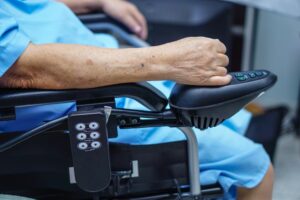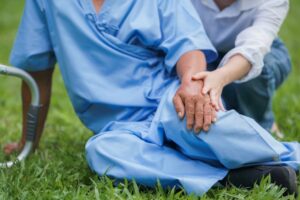Do Mobility Aids Reduce or Increase the Risk of Nursing Home Falls?
Nursing Home AbuseMobility aids, such as wheelchairs, walkers, and canes, serve as lifelines for many nursing home residents, helping them maintain independence and move safely throughout their daily routines. However, the relationship between these devices and fall prevention isn’t always straightforward. While mobility aids can significantly reduce fall risks when properly fitted and used, they can also contribute to devastating accidents.
Understanding both sides of this equation is essential for families who want to protect their loved ones. If you believe your family member has suffered a fall due to nursing home negligence, schedule a free consultation with a trusted South Carolina nursing home abuse attorney to explore your legal options for compensation.
Prevalence of Falls in Nursing Homes

Falls represent one of the most significant safety concerns in nursing homes across the United States. Of the 1.6 million residents in U.S. nursing homes and long-term care facilities, approximately half experience falls each year. Approximately one in three individuals who fall will experience a recurrence of the fall two or more times per year.
The consequences of these falls can be severe, with approximately three million older adults visiting emergency rooms (ERs) each year due to falls, and 800,000 of them requiring hospitalization for their injuries. They are the number one cause of traumatic brain injuries. Falls make up about 83 percent of hip fracture fatalities, and 88 percent of ER visits and hospital stays are for hip fractures caused by falls.
Approximately 64.2 percent of staff in nursing care facilities reported they had committed some form of abuse in the past year. Neglect is also a common aspect of abuse in nursing homes, which can quickly lead to slip and fall accidents. If you suspect or know your loved one’s fall was due to negligence, it is vital that you have a nursing home abuse lawyer investigate the fall.
How Mobility Aids Can Reduce the Risk of Nursing Home Falls
Properly prescribed and correctly used mobility aids serve as powerful tools for fall prevention in nursing home settings. When residents receive appropriate assistive devices that match their specific mobility needs and physical capabilities, these tools can provide the stability and support necessary to move safely throughout the facility. Beyond the mechanical benefits, mobility aids can boost residents’ confidence in their ability to move around safely.
When residents feel secure using their assistive devices, they’re more likely to remain active and engaged in daily activities, which helps maintain muscle strength and balance over time. Regular use of appropriate mobility aids, combined with proper staff training and supervision, creates a comprehensive approach to fall prevention that addresses both the physical and psychological aspects of resident safety.
How Mobility Aids May Increase the Risk of Nursing Home Falls
While mobility aids offer significant benefits, they can paradoxically increase fall risks when not properly implemented or maintained. Residents who receive devices that don’t match their abilities or who lack adequate training may find themselves more vulnerable to accidents than they would be without any aid at all. Common ways mobility aids increase the risk of nursing home falls include:
- Not Fitted: Improperly fitted walkers or wheelchairs can cause residents to lose balance or struggle with mobility. Devices that are too tall, too short, or have worn components create instability rather than support.
- Not Properly Trained: Lack of training on proper device usage leaves residents uncertain about safe techniques. Without proper instruction, residents may misuse equipment, which can significantly increase their risk of falls.
- Failure to Maintain Aids: Inadequate maintenance of mobility equipment can lead to mechanical failures during use. Worn brake pads on wheelchairs, loose walker legs, or damaged cane tips create dangerous situations.
- Resident Capabilities: Over-reliance on mobility aids without addressing underlying balance or strength issues can lead to accidents. Residents may attempt movements beyond their capabilities, trusting their equipment to compensate for significant physical limitations.
Staff members play a critical role in ensuring mobility aids enhance rather than compromise resident safety. When nursing home personnel fail to properly assess residents’ needs, they may be held liable for compensation. Regular evaluation of each resident’s mobility status and equipment needs helps ensure that assistive devices continue to serve their protective purpose rather than creating new hazards.
When Is A Nursing Home Liable For A Fall?
Nursing homes have a legal duty to provide reasonable care and maintain a safe environment for their residents, which includes conducting thorough assessments and effectively managing fall risks. When facilities fail to meet accepted standards of care and a resident suffers a fall-related injury, the nursing home may be held liable for damages due to vicarious liability.
Proving negligence requires demonstrating that the facility breached its duty of care and that this breach directly contributed to the resident’s injury. Examples of nursing home negligence that lead to liable falls are as follows:
- Inadequate Risk Assessments: Failure to conduct proper fall risk assessments can constitute negligence if staff don’t identify and address known hazards. Nursing homes must regularly evaluate each resident’s mobility status and implement appropriate safety measures.
- Failure to Train Staff: Inadequate staff training on the use of mobility aids and fall prevention can lead to liability in the event of accidents. Staff must be properly educated on how to assist residents safely and recognize potential risks.
- Improper or Lack of Maintenance: Poor maintenance of mobility equipment that leads to device failure during use can establish negligence. Facilities have a responsibility to inspect and maintain all assistive devices on a regular basis.
- Inadequate Staffing: Insufficient supervision of residents known to be at high risk for falls may support a negligence claim. Nursing homes must provide appropriate oversight based on each resident’s individual needs.
- Ignoring Care Plans: Failure to follow established care plans or medical orders regarding the use of mobility aids can demonstrate negligence. When staff ignore physician recommendations or facility protocols, they may be held responsible for resulting injuries.
Establishing liability in nursing home fall cases often requires a detailed investigation of the facility’s policies, staff training records, maintenance logs, and the specific circumstances surrounding the incident. Families pursuing legal action must work with experienced nursing home neglect attorneys who understand the complex regulations governing nursing home operations and can effectively demonstrate how the facility’s actions or omissions contributed to their loved one’s injury.
What to Do After a Nursing Home Fall

When a nursing home resident experiences a fall, the immediate response can significantly impact both the resident’s recovery and any potential legal case. Families must act quickly to protect their loved ones’ health and preserve critical evidence that may be needed later. Understanding the proper steps to take after a fall helps ensure the best possible outcome for the resident while protecting their legal rights, including the right to financial compensation.
Seek Medical Attention
The number one priority after any nursing home fall is ensuring the resident receives prompt and appropriate medical care. Do not delay medical care. Even falls that initially appear minor can result in serious injuries like fractures, internal bleeding, or head trauma that may not be immediately apparent. Insist that facility staff arrange for a thorough medical evaluation, preferably by a physician rather than just nursing staff.
If you have concerns about the adequacy of care provided by the nursing home, don’t hesitate to request transfer to a hospital emergency room for more comprehensive evaluation. Document all medical treatment received, including X-rays, CT scans, medications administered, and any changes to the resident’s condition following the fall.
Document the Fall
Proper documentation of fall incidents provides essential evidence for both medical treatment and potential legal action. Begin by obtaining a detailed incident report from the nursing home, which should include the date, time, location, and circumstances of the fall, as well as the names of any witnesses present. Other documentation consists of the following:
- Taking photographs of the area where the fall occurred, hazards, and injuries.
- Recording the condition of any mobility aids involved in the fall incident.
- Interviewing witnesses, including other residents, family members, or visitors who may have seen the fall.
- Noting your loved one’s physical and mental condition before and after the fall occurred (changes in cognition, health, and mobility).
- Keeping detailed records of all communications with nursing home staff, administrators, and medical personnel regarding the fall.
Save copies of all medical records, incident reports, and correspondence related to the event. Written documentation created close to the time of the incident often carries more weight than recollections recorded weeks or months later.
Report to Nursing Home Staff
Notify the nursing home administration immediately about the fall, even if the floor staff are already aware of the incident. Speak directly with the director of nursing or facility administrator to ensure the fall receives appropriate attention at the management level. Request a thorough investigation into the circumstances surrounding the fall and request a written report of the findings. Ensure the facility updates the resident’s care plan to address any new risk factors identified as a result of the fall.
Report to Your State’s Regulatory Agency
Contact your state’s nursing home regulatory agency to file a formal complaint about the fall incident, particularly if you suspect negligence played a role. Most states have dedicated hotlines or online reporting systems for nursing home complaints. Provide detailed information about the circumstances of the fall, any suspected violations of care standards, and concerns about the facility’s response to the incident. Regulatory investigations can uncover patterns of problems that may not be apparent from a single incident and can help protect other residents from similar risks.
Consult a Nursing Home Abuse Lawyer
If you suspect that nursing home negligence contributed to your loved one’s fall, consulting with an experienced nursing home neglect attorney is essential for protecting your family’s legal rights. Many fall cases involve complex questions about the facility’s duty of care, staff training, equipment maintenance, and adherence to safety protocols, which require thorough legal analysis.
A nursing home abuse lawyer can help determine whether grounds exist for a negligence claim and guide you through the process of seeking compensation for injuries. Benefits of having legal representation include:
- Comprehensive Evaluation: Evaluating the strength of your potential case based on available evidence and applicable laws. Attorneys can assess whether the facility’s actions constituted a breach of their duty of care.
- Thorough Investigations: Investigating the facility’s history of safety violations, staffing issues, and other factors. Legal professionals have access to resources that can reveal patterns of negligence that may not be apparent to families.
- Communications: Handling all communications with the nursing home’s insurance company and legal representatives, providing you peace of mind. Facilities often have experienced defense teams that may try to minimize their liability.
- Valuing Claims: Calculating and negotiating appropriate compensation for medical expenses, pain and suffering, and other damages. Attorneys understand how to value nursing home injury cases and negotiate fair settlements.
- Ensuring Compliance: A nursing home abuse lawyer ensures meeting legal deadlines and procedural requirements that may impact your case. Missing important deadlines can result in the loss of your right to pursue compensation.
Legal action can not only provide compensation for your family but also create accountability that may prevent similar incidents from happening to other residents. When nursing homes face consequences for safety failures, they have stronger incentives to improve their care practices and invest in proper staff training and equipment maintenance.
Contact an Experienced Nursing Home Abuse Lawyer Now
If your loved one has suffered a fall in a nursing home that you believe resulted from facility negligence, don’t wait to seek legal advice. Many nursing home injury cases are subject to strict time limits for filing claims, and significant evidence can be lost or destroyed if action isn’t taken promptly.
Schedule a free consultation with an experienced personal injury lawyer who can evaluate your case and explain your legal options without any upfront cost or obligation. Most nursing home abuse lawyers work on a contingency fee basis, meaning you don’t pay if they don’t win your case.
Nathan Hughey, an attorney and fourth-generation South Carolinian, founded Hughey Law Firm in 2007. Before that, he spent five years defending nursing homes and insurance companies. Leveraging his experience, he now advocates for those injured or wronged by such entities, securing over $290 million in verdicts and settlements.
